Skateboards: types, best models, tips for choosing and using
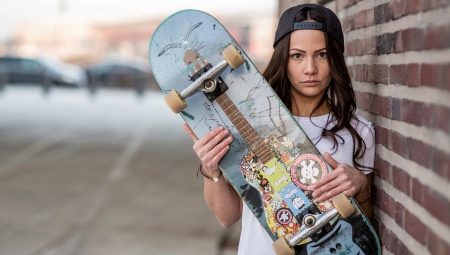
Skateboarding is very popular among young people and highly appreciated by extreme sports enthusiasts. The high demand for roller boards is due to their acceptable cost and wide consumer availability. In addition, skateboarding is a very interesting activity and promotes the development of coordination and strengthening of the vestibular apparatus.
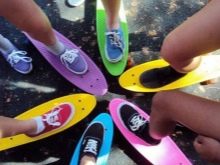
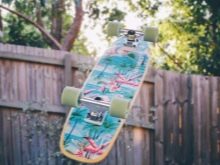
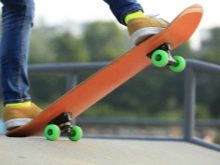
What it is?
The skateboard owes its name to the English transcription of the word skateboard, which literally means “skateboard”. Skateboarding (performing various tricks on a skateboard) was recently included in the program of the Summer Olympic Games... The origin of this sport goes back to the 30s of the last century, when surfers began to use skateboards to keep fit in the offseason.
Over time, skateboarding came to the masses and became a favorite pastime of a large number of young people. During the short history of its existence, the skate has been repeatedly improved and acquired more or less modern outlines in 1958. A little later, namely in 1971, Richard Stevenson invented leg bindings and slightly changed the design of the board itself, after which it became more obedient and maneuverable.
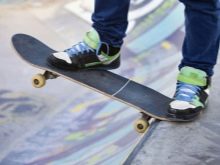
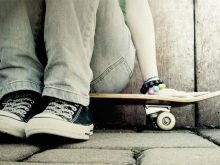
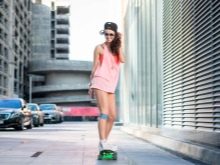
Peculiarities
The high consumer demand for skateboards is due to a number of important advantages of these unique designs.
- The modern skate is an unusual vehicle, where you can not only perform various jumps, but also take leisurely walks, as well as move around in a big city.
- Due to the small size and low weight of the skate, with it you can go down the metro, use all types of ground transport, and also take it with you to shopping centers and cinemas.
- Due to the fact that the skateboards are constantly under the supervision of the owners, the likelihood of their being stolen is minimal.
- Regular skateboarding develops well the muscles of the legs, back and allows you to always be in great physical shape.
Skateboarding is a very spectacular sport and has thousands of fans all over the world. It is not for nothing that June 21 is officially recognized as International Skateboarding Day and is celebrated in many countries around the world.
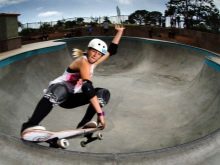
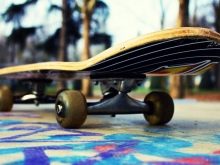
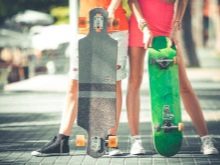
Differences from a penny board
Despite their superficial resemblance, penny boards differ from classic skateboards. They are smaller in size, their decks are made of plastic and are bent upwards only on one side. Thanks to this design, the deck flexes slightly while driving and absorbs wells well when driving on uneven roads. Mini skateboards are equipped with wide polyurethane wheels and are very comfortable for long walks.
Unlike traditional skateboards, penny boards are not suitable for somersaults and are designed for calm, measured riding.
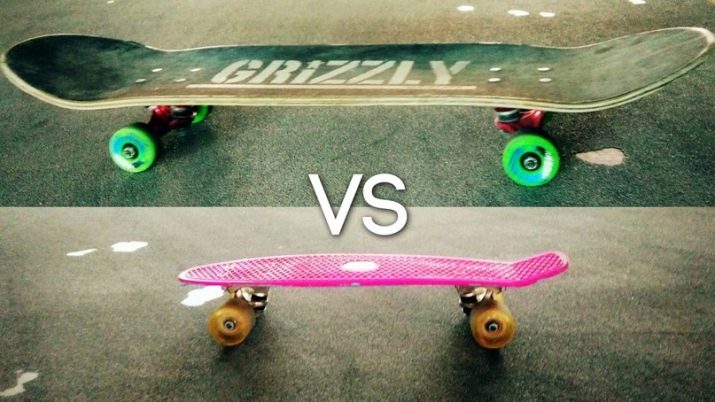
The principle of the device
Modern skateboards are composed of elements such as deck, wheels, bearings, bushings, suspensions and grip.
Soundboard
This design detail is the most important part of a skateboard and largely determines its intended use. The following materials are used for the manufacture of decks:
- Canadian maple is considered the best option for making a skateboard and is highly valued by professional athletes;
- the Chinese maple loses quite a bit to its overseas counterpart, but it has a lower cost and is quite suitable for making trick models;
- plastic is also widely used for making skateboards and has good strength and excellent shock-absorbing effect.
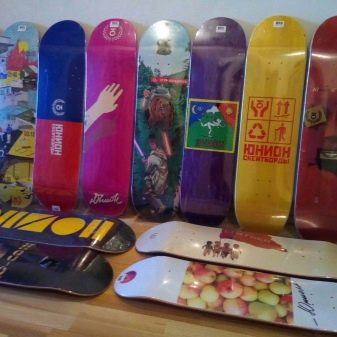
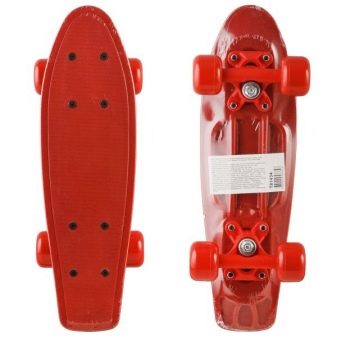
Wooden decks have a multi-layer structure with 6 to 9 layers. The most common are 7-layer boards, accounting for up to 90% of the skateboard market. The decks of some sports models are equipped with plastic pads on the lower side, allowing you to perform various somersaults using the sliding technique on the railing. The width of the decks ranges from 12 to 26 cm and is in direct proportion to the type of skateboard.
The wider the board, the more stable the skate, and the higher its speed characteristics. Conversely, narrow skateboards are more maneuverable and obedient, but not as stable and fast as wide ones. As for the length of the deck, depending on the type, it ranges from 16.9 ″ to 55 ″, the standard length of the classic model is 31 ″ or 78.7 cm.
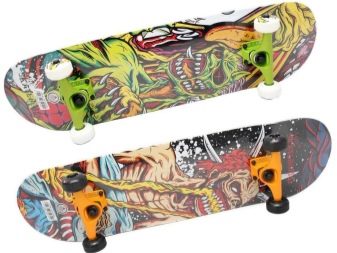
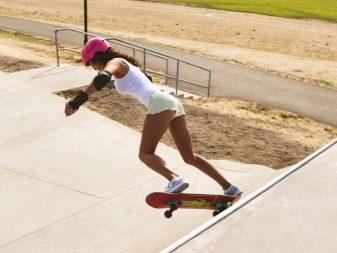
According to the shape of their profile, the decks are straight, bent on one or both sides, or equipped with lateral bends (concave). Straight decks are designed for a relaxed ride, while curved decks are used for various tricks. According to their execution, the boards are whole or segmented, which also depends on the type of skateboard.
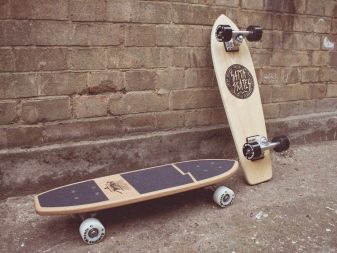
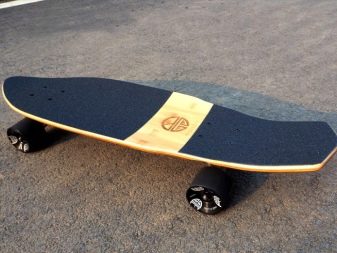
Wheels
The next most important part of the skateboard is the wheels. They are available in a wide variety and are made of polyurethane. The main characteristics of wheels are diameter, width and stiffness. The diameter depends on the dimensions of the deck and the riding style and ranges from 48 to 75 mm. The standard wheel size for a classic skateboard is 5.4 cm in diameter.
When choosing rollers, you need to know that the larger their diameter, the faster the skateboard picks up speed and rolls better... Models with small rollers accelerate slowly but are more agile. These samples are designed to perform complex tricks and jumps.
The choice of the diameter of the rollers depends on the operating conditions of the skate. So, models of 54-60 mm have proven themselves perfectly on tiles and cracked asphalt, however, when performing bends, they often run into the deck. Rollers measuring 51-53 mm run well on a relatively flat, but rough road, devoid of potholes and holes, while samples with a diameter of 48-50 mm are suitable for driving on flat concrete or special areas of skate parks.
The thickness of the rollers depends on their diameter and type of skate and reaches 5.7 cm. It is important to understand that the worse the quality of the road, the wider the rollers should be.
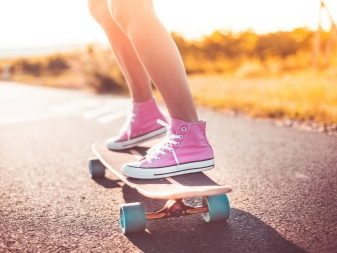

Roller stiffness is a measure of their resistance during mechanical action. Each video has its own markings, which are represented by a number and a letter. Wherein the larger the numerical value, the harder the wheel. The soft rollers, marked 73A-79A, are designed for a comfortable ride. Such models provide the skateboard with obedience in control, but they wear out rather quickly and require replacement.
Wheels of medium hardness are marked 80A-85A and are the "golden mean"... They are able to provide high traction, make the skate more agile and improve shock absorption. These are ideal for ramp riding.
Rigid models are manufactured with 86A-100A markings and have a long service life. They do not lend themselves well to wear and tear and endow the skate with excellent speed qualities and good acceleration. The disadvantages of hard wheels include their inability to dampen vibrations when driving on uneven roads.


Bearings
This element of the skate structure is responsible not only for its speed and wheel condition, but also for the safety of the rider. Therefore, when choosing a model, you should be very careful and purchase products only with high-quality bearings. According to their performance and reliability, bearings are divided into 5 classes, which are indicated by odd numbers and must be indicated in the data sheet of the skate.
- ABEC-1 class represented by the most budgetary and weakest models, which are put on children's skateboards and inexpensive copies for beginners. It will not be possible to accelerate strongly on such bearings, and their service life leaves much to be desired.
- ABEC-3 class Comes with standard bearings with good strength for use on hobby skateboards. They are capable of providing pretty good speed, although they do not reach professional models.
- ABEC-5 class is the most numerous category and fits on most skateboards. Fives are great for everyday riding, providing good acceleration and excellent roll-off.
- ABEC-7 class are already much more expensive and are installed on professional sports boards. The models are very accurate and reliable and allow you to reach serious speeds, for which they are called "racing".
- ABEC-9 class presented by the most expensive samples, however, due to the unfinished design, it did not receive wide distribution among professional skateboarders. "Nines" do not withstand overloads and quickly deform.

Grip tape
A grip tape is an abrasive pad that is located on the top of the deck and provides it with a secure grip on skateboarders' shoes. In addition to a practical task, grip tapes also perform a decorative function, defining the appearance of the skate. The skins come in a wide range of colors and are often patterned. However, experienced skateboarders find colored grips less effective and less durable and prefer the classic black or gray sandpaper.
If desired, you can paint them with acrylic markers, using stencils for this, or drawing by hand.

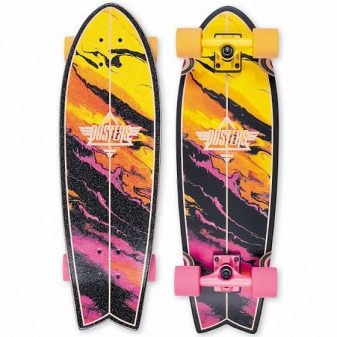
Deck suspensions
Suspensions (in a professional environment - tracks) are a simple structure by means of which the rollers are attached to the board. The tracks are responsible for the maneuverability of the skate and the safety of cornering.The principle of operation of the suspensions is quite simple and consists in the following: with lateral pressure on the deck, they make the wheels turn in one direction or another, and when the center of gravity is aligned, they return them to their original position. The dimensions of the tracks are chosen based on the width of the deck so that the wheels fixed on the hanger do not protrude beyond the deck.
For example, a 19 cm wide skate deck requires a 12.1 cm suspension, while a 21 cm deck requires a 13.3 cm track.
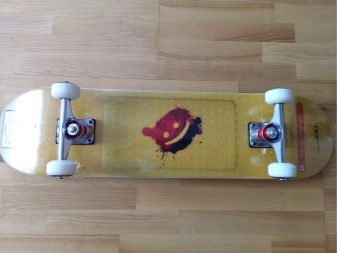

The following materials are used for the manufacture of pendants:
- plastic - used on children's models, is inexpensive and copes well with small loads;
- aluminum - is the optimal balance of quality and lightness, which is why it is found especially often;
- steel – although it is much stronger than previous materials, it is rarely used due to its high weight.
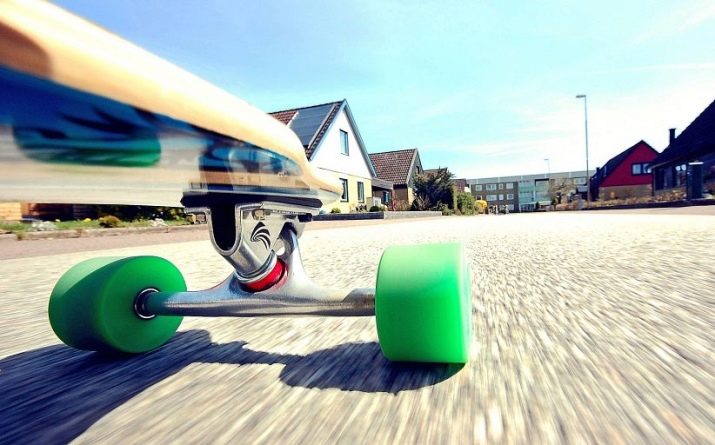
The main characteristic of the pendants is maximum load level, which varies from 20 to 120 kg and consists of the mass of the skateboarder and the maximum load arising from the performance of the jumps. An equally important parameter is suspension height... So, lowered tracks facilitate flip-tricks and add stability to the ride, however, they require high skill and the installation of small wheels. The tall tracks are designed for large wheels and perform well at serious speeds and on long journeys.

Bushings
These small parts are part of the suspension and are small shock absorbers made of technical rubber. The higher their rigidity, the more stable the skateboard will roll, and vice versa - the softer the bushings, the worse the straight rolling, but the easier the turns.
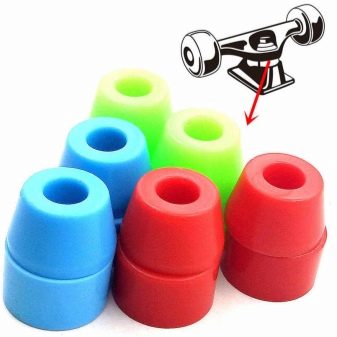
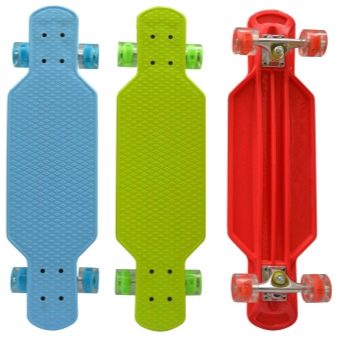
Additional linings
To reduce the load on the suspensions and to protect the wheels on steep bends, special pads are used. Most often they are installed on boards equipped with wheels of large diameter; they are not needed for models with wheels of 5-5.5 cm.
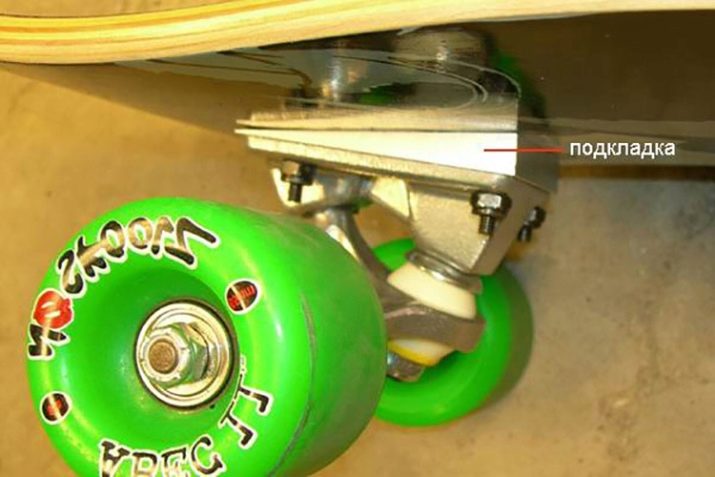
Species overview
Today there are a large number of skateboard modifications, many of which have been transformed into separate types. They, as a rule, already have their own name, special riding technique and rather remotely resemble their progenitor. The following are the most popular types of skateboards used both for the execution of complex elements and for city driving.
- Classic skateboard presented in the form of a four-wheel board with curved edges and is intended for extreme driving. Traditional samples are distinguished by a considerable margin of safety, excellent stability and beautiful design. Among the disadvantages are the high cost of many models, poor roll-forward and unsuitability for high-speed travel on city roads. Adult classic skateboards cost from 1,000 to 18,000 rubles, and for a model for children you will have to pay from 500 to 2,000 rubles.
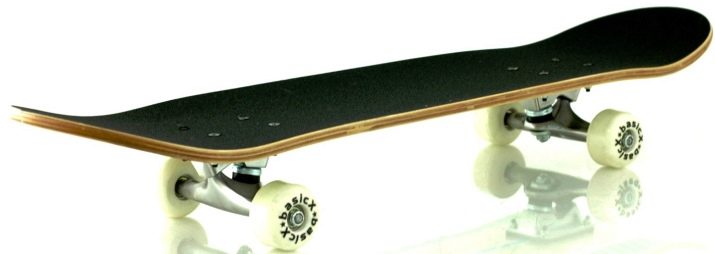
- Freeboards have a bamboo or maple deck and 6 wheels that rotate 360 degrees, allowing the board to go in any direction. The modified suspensions are equipped with weights that give the model maximum stability and allow it to develop serious speeds. Freeboards are quite maneuverable, however, they require certain riding skills. The length of the deck is selected according to the height of the rider. The cost of models is from 13,000 to 15,000 rubles.


- Rollersurf is a hybrid of a skateboard and inline skates. The product consists of 2 one-wheel parts connected by means of a torsion spring. Four-wheeled roller-surfing models are also found, however, they are not widespread and are rarely used. Rollersurfers are able to accelerate well and do not require constant push-off. Cost - from 1,350 rubles.
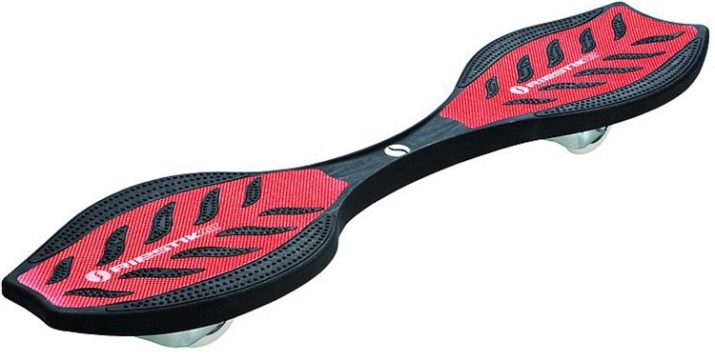
- Streetboards (snakeboards) outwardly they resemble classic skateboards, however, they have a prefabricated deck, consisting of one static block and two movable ones attached to it on the sides.The models are distinguished by their unusual appearance, good maneuverability and good stability. Cons - short-lived and not suitable for beginners. The price range of streetboards is from 2,000 to 25,000 rubles.

- Longboard is a type of skateboard and has a long deck with massive wheels. The deck reaches 100-140 cm in length, the rear and front suspension is as far as possible from one another, and the massive wheels protrude beyond the deck. The model is designed to overcome long distances and long descents, develops a good speed, is very stable, durable and can be used as a city transport. Among the disadvantages are noted high cost, heavy weight and difficulty in performing tricks... The cost of longboards is from 1,500 to 28,000 rubles.
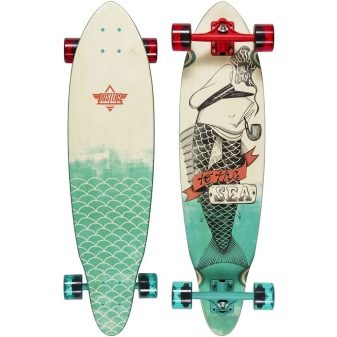
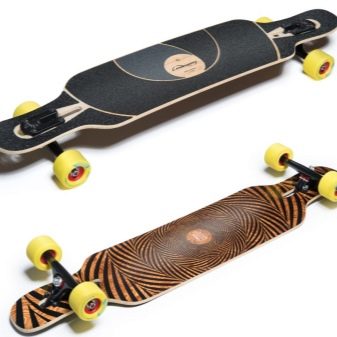
- Mountainboards are skateboards for skiing in the mountains. The models are equipped with 8 "inflatable wheels, so they are able to move freely on bad roads and grass. The length of the board is 100 cm, width is 30 cm. Mountainboards are equipped with a powerful spring suspension, leg mounts, and sometimes a motor. , excellent shock absorption, good speed and the ability to overcome steep climbs. Among the disadvantages are high weight and high cost.
So, a board without a motor will cost over 3,000 rubles, for a self-propelled sample you will have to pay over 60,000 rubles.

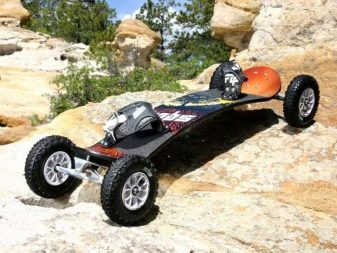
- Freestyle skateboard consists of a narrow deck and wheels offset to the center. This look is one of the earliest and is intended for performing fatland flips.

- "Old school" - the very first type of skateboard, which became widespread in the 70s of the last century and was used to perform basic tricks. The models had a wide nose, due to which they were distinguished by high stability.

- Stoboards characterized by high stability and fast acceleration, designed for long journeys. The design of the species includes 4 massive wheels, a metal frame and folding bow and tail sections.
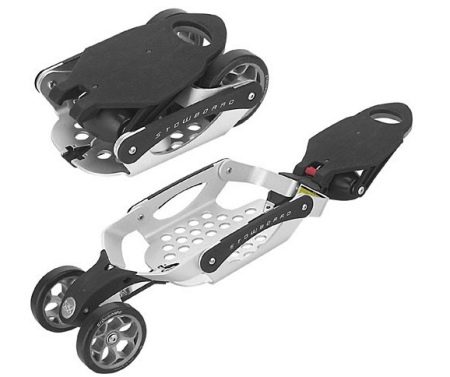
- Waveboards and ripsticks are two-wheeled models, consisting of 2 independent parts, fastened by a torsion spring. In order to set such a skate in motion, it is enough to move the center of gravity of the body from one leg to the other without pushing off the ground. The advantages of the view include good acceleration, high maneuverability and ease of performing tricks. Disadvantages - instability and unsuitable for beginners. Price - from 2,000 to 15,000 rubles.
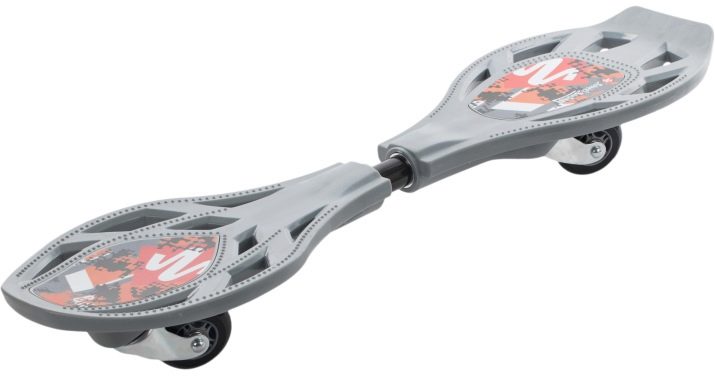
- Electric Skateboards equipped with a motor and brakes. The skate is controlled by shifting the center of gravity from one leg to the other.
So, when you press on the front edge, the board begins to move, on the tail - it stops. Some samples come with a remote control.
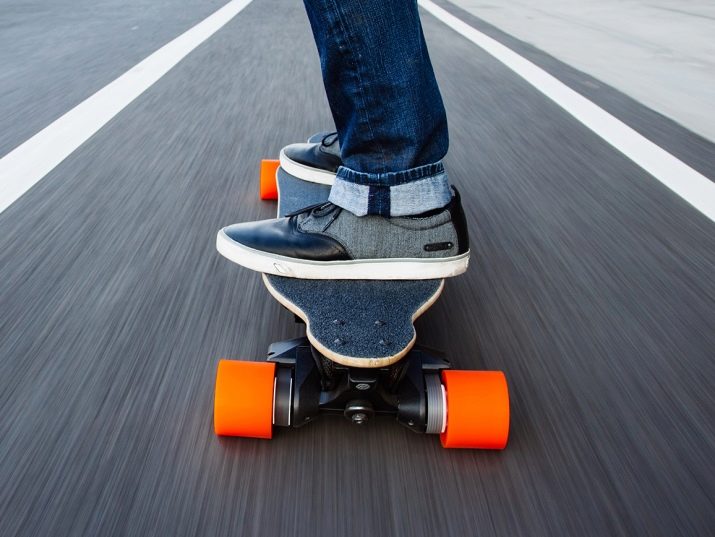
Manufacturers and popular models
The modern extreme sports market offers a wide range of skateboards. Below are the top-ranked samples.
- US Baker stunt model equipped with a Canadian maple deck, light weight and high impact resistance. The skate is great for practicing jumping and is recommended for beginners. The model has one drawback - the high price.

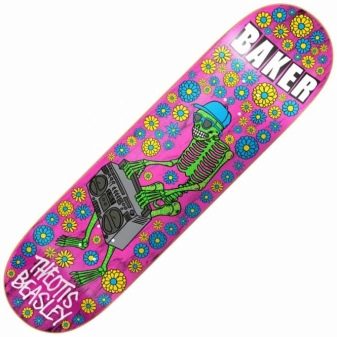
- Children's skate from the Australian manufacturer Penny Board is available in two lengths - 22 and 28 ″, has wheels with a diameter of 5.9 cm with a stiffness index of 78A and racing bearings ABEC-7. The model is intended for high-speed driving and is not recommended for performing stunts. The disadvantages include a narrow deck and high cost.
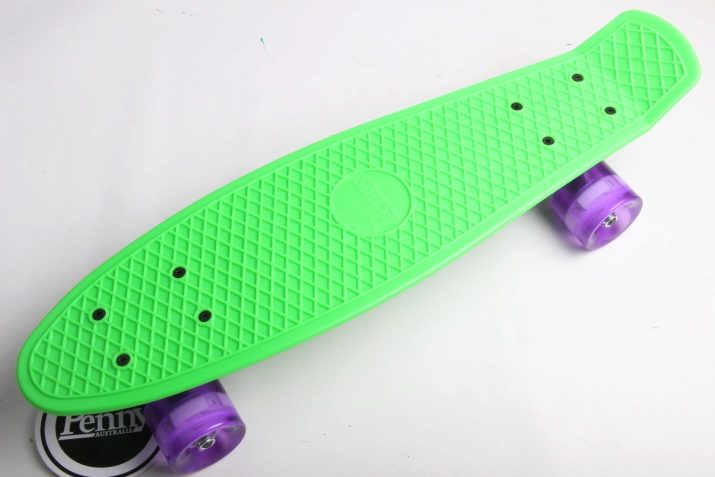
- Oxelo Yamba Wood Classic Skate Cruiser is produced in China under a French brand and is designed for long trips on city streets, including bad asphalt and tiles. The model has excellent rollback, is lightweight and accelerates quickly. Of the minuses, low moisture resistance is noted, which is why the deck should be protected from prolonged contact with water.

- Skate Trick 300 from the Chinese firm Roces has a 9-ply Chinese maple deck measuring 31x7.50 ", solid aluminum suspension and looks very stylish. The model is of good quality and is well suited for beginners.
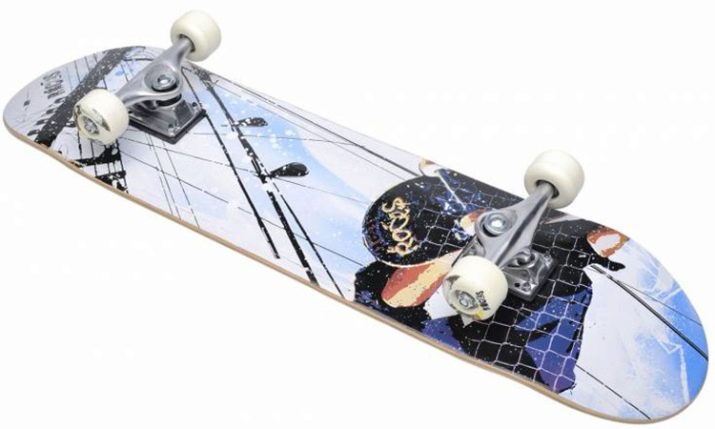
- Kids skate Kreiss 57 cm made in turquoise color and equipped with a plastic fish-shaped deck. The model is equipped with 5.9 cm polyurethane wheels and ABEC-7 bearings. The skate is so compact that it fits easily into a spacious backpack. The board is designed for riders weighing up to 100 kg and a height of 120 to 170 cm.

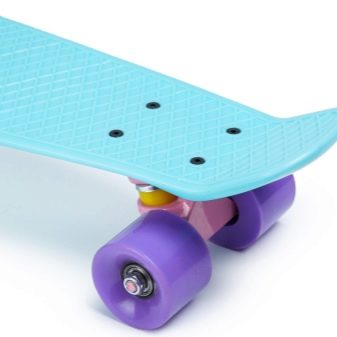
How to choose?
In order to choose the right skate, you should pay attention to a number of important points.
- For beginners, a 7-layer classic skate made of beech or birch is suitable.
- For boys and girls, it is better to choose models with bearings of the 1st and 3rd classes, a teenager needs a fifth grade.
- Experienced skateboarders to practice tricks a model with wheel rigidity up to 95A is suitable, for beginners - up to 80A.
- Beginner board width must be at least 20 cm.
- Novice skateboarders are advised to choose models with rigid bushings, which will make the skate more controllable on a stable ride. Bushings that are too soft can only be used by experienced freestyle athletes, and amateurs are better off choosing bushings of medium hardness.
- Kids will love the model with glowing wheels, backlit and bright decals on the deck.
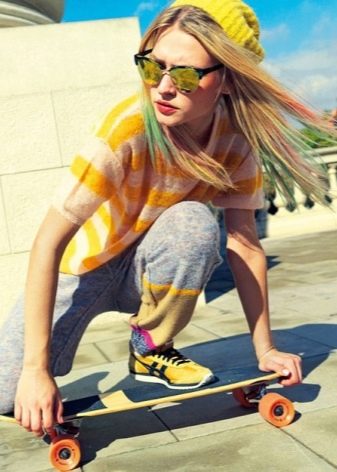
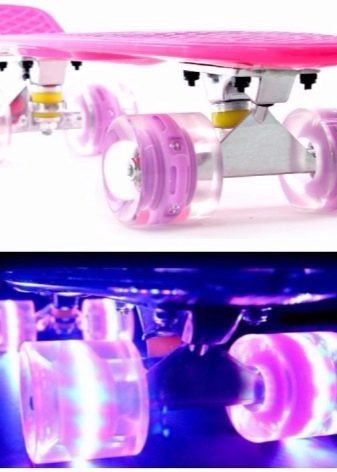
Necessary accessories and clothing
For skateboarding, you must choose loose, breathable clothing and special shoes. Better to get good skate boots, but if this is not possible, then you can take sneakers or sneakers with non-slip flat soles. It is also necessary to take care of protection in the form helmet, knee pads and elbow pads.
In most cases, skate park security services do not allow people without special equipment to enter their sites.
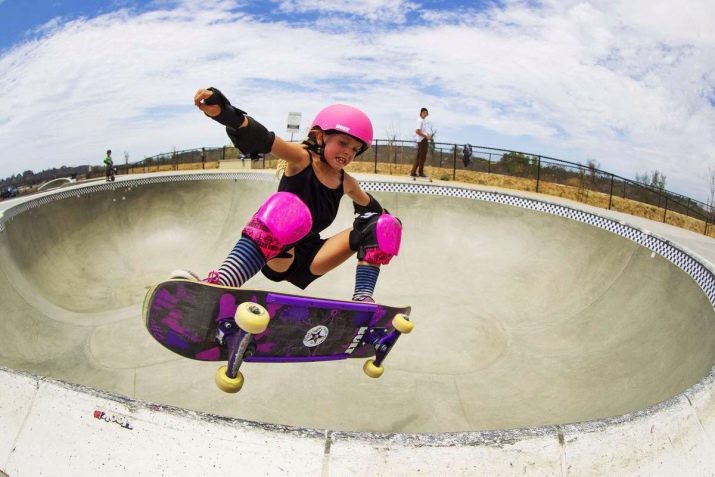
Where to train?
Complete training site depends on the riding style. For example, for a “flatdend” you will need asphalt and horizontal concrete slabs, for a street “street” - stairs and railings, for “freestyle”, in which tricks are performed in one plane, any platform will do, and for a “turn” you will need a ramp. Park-style skaters will be able to be content with specially designed skate parks for them. For beginners, an uncrowded alley with a slight slope and no curbs is suitable.
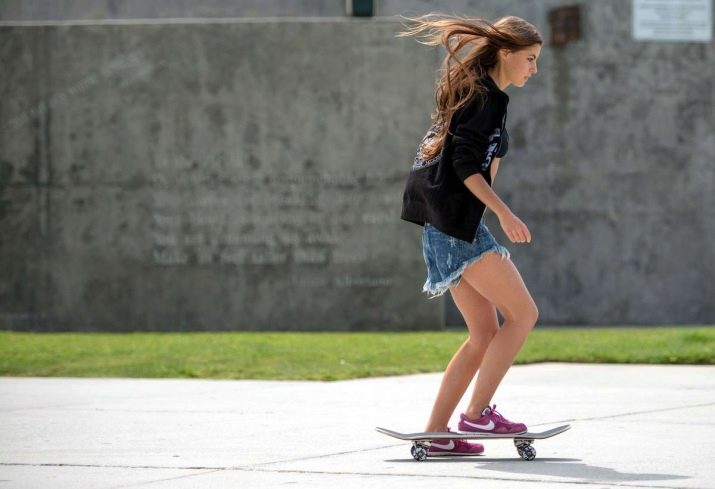
Operating tips
Before you start skating, you should it is necessary to correctly assemble and adjust the suspension. Most models have the ability to customize the tracks depending on the riding style. To do this, they are twisted more or, conversely, they are slightly weakened by adjusting the operation of the shock absorbers. During the operation of skateboards, it is necessary to monitor the presence of grease in the bearings and clean the wheels from dirt and dust in time. Otherwise, they will quickly begin to creak and spin badly.
After each use, regardless of the weather, the skate should be wiped with a clean cloth and stored in a dry, ventilated place. It is prohibited to store boards outdoors.
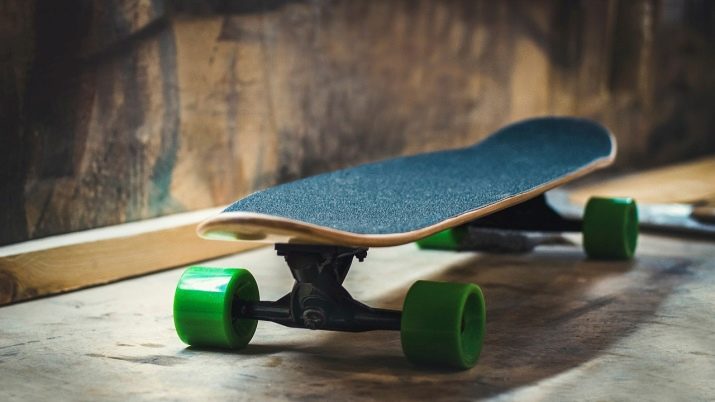
Recommendations for beginners
It is recommended to start training at home. on a soft carpet away from sharp corners. The soft grass in the nearby park is also good. First you need to learn to stand on the board with both feet, maintaining balance. Then you should determine the supporting and pushing leg, stand on the skate and try to push off slightly. It is advisable to do this on a flat surface.
The next step is to learn how to put the kick foot on the deck and roll until the skate stops. The next step will be to practice the skill of maneuvering by tilting the body back and forth. And only after the skill of free-running skate control comes, under the guidance of an experienced instructor, you can proceed to learning easy tricks.
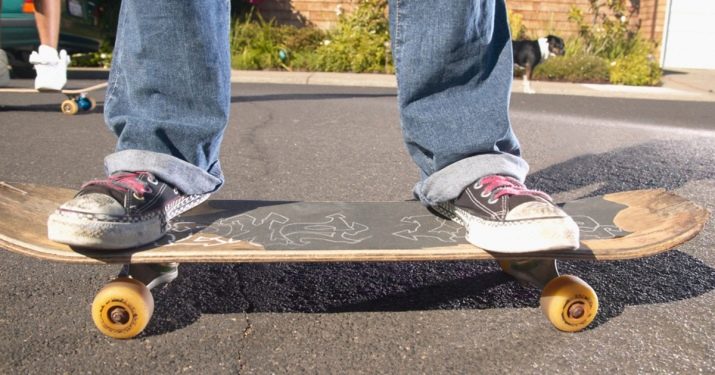
For information on how to choose a skateboard, see the next video.








